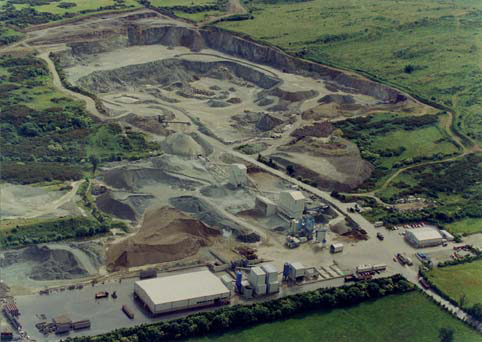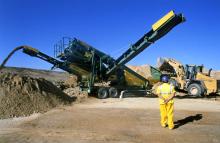
Whatever the future may hold, Ireland is two different countries and two different markets for aggregates and rock. But the crisis is hitting both of them, reports Adrian Greeman
The financial crisis has directly impacted on the aggregates business in Ireland Family-owned Kilsaren Group operates 18 quarries across Southern Ireland
A single factor unites Ireland at the moment - the credit crunch. Both Northern Ireland and the
Republic of Ireland (ROI) have suffered from the slowdown in the world economy that is hitting construction and especially house building at the moment.
Aggregates demand in the ROI has 'dropped off a cliff' to quote the
"Housing has virtually stopped and that was a major engine of the economic boom of recent years," said ICF chief executive Gerry Farrell. "We were building 90,000 houses a year and that could be as little as 20,000 this year. Other sections of construction are continuing for the meantime including public spending on infrastructure which is helping to maintain demand.
"But a major factor influencing aggregate demand until the end of 2008 was farm improvement work." Under European directives on waste management, farms had to expand their capacity to deal with nitrogenous waste by building treatment and retention structures.
In a rural economy like Ireland this building work created a very large demand for concrete block and in situ concrete, using substantial aggregate output and aggregate limestone for cement making.
"It probably explains why the fall in demand was limited to around 15% last year, on 2007," said Farrell. "But the trend is much steeper now." In Northern Ireland the economic crisis equally has torn into employment and business on quarries and gravel pits throughout the province, in what the
Job losses
Most of all, employment has been hammered with some 1300 jobs lost. The story is not over yet, according to MPA regional director Gordon Best, who thinks at least 250 more redundancies will be made in 2009. .
The impact and devastation is especially felt in both these countries because of the mainly small and family nature of quarry businesses in Northern Ireland. The MPA's recently increased membership of 116 firms operates just 160 sites for example, with only a few large firms among them and the association represents about 95% of the industry.
In ROI the businesses are predominantly just as small, though there is more of a mix of medium size and some large players as well, including the
"But mostly firms are spread right across the country and are very local," said Farrell. Transport distances tend to be very low and are not more than 25km for most gravel deposits.
The output used to be largely gravel pit produced, often operating seasonally, though in recent years this has become more balanced against crushed rock with an even split in terms of volume between the two.
Geology To some extent the diversity of sites reflects the very rich geology of the island. "The whole island is one enormous glacial deposit zone," said Sean Finlay, recently elected president of the Irish Mining & Quarrying Society. "The midlands are virtually all limestone, which has led to our large cement industry and there is some igneous material in places on the coast." There has always been a supply nearby said Finlay, and long distance rail or water transport has not been needed.
Northern Ireland has a wider variety of rocks, including the famous basalt of the Giant's Causeway, metamorphic rocks and hard gritstone. Partly for this reason it exports a fair amount of aggregate to the mainland UK, especially for road use, and its annual output is disproportionately large compared to the population.
"We have about 1.8million people here, which is 3% of the UK population, but we produce over 27million tonnes of aggregate, which is 12% of the total," said Best.
The industry is a significant part of the economy therefore and finding ways to help it is important in the downturn, he argues. Its fate is also linked to a large equipment manufacturing sector which grew up alongside, producing enough quarry and aggregate machinery for 30% of worldwide demand.
Imports into Northern Ireland became an issue some years ago and contribute to some differences with the mainland UK, though in the main the industry is regulated by the same legislation. The critical issue was the aggregate tax, or rather levy , imposed by the British government at £1.60 (€1.74) per tonne for the whole industry, with the intent of improving environmental standards, though it has long been disputed by producers.
"We believed it was a stealth tax for other purposes," said Best. Partly because of the tax the then QPA section for Northern Ireland came into being, expressing special concern for the region because of its border with ROI.
"This is the only part of the UK with a land border with another country which does not have a levy," explained Best. The result was to create a disparity in prices which combined with a difference in exchange rates between the pound and Ireland's Euro, led to substantial import of aggregates, at least within range of the border.
"There was an imbalance and both legal and illegal operations sprang up which endangered the viability of the indigenous industry," said Best.
The MPA's regional body negotiated a special arrangement with the UK government whereby quarries and pits could get a rebate or credit of 80% of the tax, up until 2011. In return they had to implement a set of environmental improvements which Best said were not any greater than any best practice would lead to anyway, though it could cost smaller and perhaps more old fashioned family firms a substantial amount to upgrade their business.
But the result has been to push the country along a path towards better and more sophisticated standards he asserts. "It levels the playing field for everyone - you must be registered in the scheme to win government procured contracts for example," he said.
Ironically there has been something of a reversal in the economics at the Irish border because of the fall in the value of the pound against the Euro in the last 12 months. Aggregate is now cheaper in Northern Ireland and is going south.
Other planning issues affect the two countries. Both have been dealing with updated quarry regulation in recent times which, although set out in different form, achieve similar effect.
In the ROI there are upgrades required under legislation in the Planning and Development Act 2000, with changes brought forwards by the Health & Safety Authority in 2008. In Northern Ireland on top of new regulations, there is also the so-called Review of Old Mining Permissions (ROMPS) which will require a phased re-examination of the original planning permission for various categories of quarry to bring them into line with modern requirements. This was done in the UK mainland some years back but is outstanding for Northern Ireland.
The ROMPS scheme was due initially in 2006 but was delayed to bring it into line with other legislation and is now due to be implemented during this year. It will obviously add to the costs of an operator making the necessary changes and even in simply gathering the required information about environmental impacts of various types such as dust and noise, along with fairly extensive documentation to go with it.
For Best, this is a good reason to delay the ROMPS implementation a little longer. "It's quite a burden for a lot of small companies at this particular moment and we would argue that because of the aggregate levy scheme, many of them have been upgrading their environmental standards anyway," he said.
Other issues have also been affecting the industry both north and south of the border in recent years. One that is gathering increasing attention is sea-won aggregates. Neither Northern Ireland or the ROI makes much use of these at present but attention is turning to the potential from the Irish sea, particularly as their use could be less carbon costly than high expense land transport of aggregate, according to Koenraad Verbruggen at the Geological Survey of Ireland.
Together with Geoscience Wales and the University of Cork, the GSI recently completed a
The GSI is also taking steps in the creation of a national mapping survey of aggregate resources, or potential resources. At present this has taken place primarily via county authorities which have the primary planning responsibility in Ireland said Verbruggen. Costs were shared 50:50 between the counties and the non-commercial GSI.
"Now as part of the National Development Plan we are in the second year of work aggregate policy mapping. It is mainly a compilation and assessment exercise because there is plenty of past mining and extraction activity, with additional data from boreholes over 150 years," explained Verbruggen.
A similar scheme would be highly useful in Northern Ireland said Best, "It has happened in the UK but we are one of the regions which has not had it, and it would be very useful to avoid sterilising resources for the future, especially as our industry exports a good amount." He would also like to see studies of the offshore resources for Northern Ireland. But both he and his counterparts in the ROI have immediate issues to think about in seeing their industries survive at present.
In both countries the critical issue is to see that at least public infrastructure spending should continue. In the ROI hopes are focused on the National Development Plan and the €8billion which is to be spent on roads, water development, hospitals, public transport and other infrastructure.
The ICF's Farrell said that the money has been declared sacrosanct by Dublin. "And it needs to be, since agricultural spending, housing and commercial development is not happening. As well as creating demand and jobs, we also need the infrastructure to develop." But both he and Finlay are cautious, even sceptical that spending will hold up. "Government revenue is declining with the cutbacks in economic activity and so it becomes more difficult to fund projects," said Finlay.
In Northern Ireland in recent years spending has increased substantially, with £3.5billion (€3.8billion) spent on construction in the 12 months to June 2008. Part of this is due to a new long term perspective in the Investment Strategy for Northern Ireland aimed at enhancing and updating its infrastructure in the wake of former troubles.
Public investment is going to be £1.5billion (€1.6billion) in capital work in 2009, according to David Gavaghan chief executive of the Strategic Investment Board.
But the industry remains concerned. "We know that currently there is a Northern Ireland investment strategy and we welcome the fact that there are major capital projects in the pipeline, some of which we will see later this year but most will not happen until after 2012. What do we do in the meantime?" asked Best. "There are now even question marks over the financing of some of these major projects".
Fingers are crossed both sides of the border.
Fact File: Northern Ireland
No. of quarry operators 116
No. of quarries 190
No. of employees 1900
Total production 29.5million tonnes
Sand and gravel 19million tonnes
Crushed rock 8million tonnes
Recycled aggregates 2.5million tonne Source:
QPA 2007
Fact File: REPUBLIC OF Ireland
No. of quarry operators . 250
No. of quarries. 450
No. of employees. 5100
Total production. 134million tonne
Sand and gravel. 54million tonnes
Crushed rock. 79million tonnes
Recycled aggregates. 31million tonne
Source: UEPG 2006







